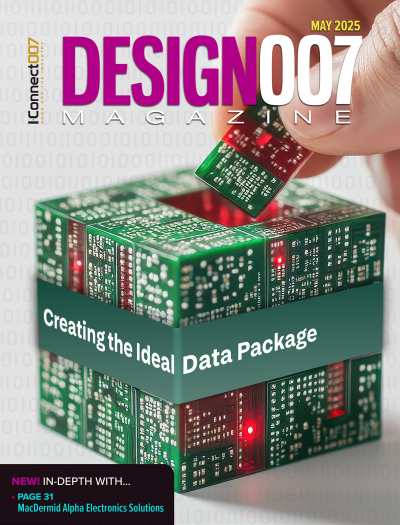-

- News
- Books
Featured Books
- design007 Magazine
Latest Issues
Current Issue
Showing Some Constraint
A strong design constraint strategy carefully balances a wide range of electrical and manufacturing trade-offs. This month, we explore the key requirements, common challenges, and best practices behind building an effective constraint strategy.

All About That Route
Most designers favor manual routing, but today's interactive autorouters may be changing designers' minds by allowing users more direct control. In this issue, our expert contributors discuss a variety of manual and autorouting strategies.

Creating the Ideal Data Package
Why is it so difficult to create the ideal data package? Many of these simple errors can be alleviated by paying attention to detail—and knowing what issues to look out for. So, this month, our experts weigh in on the best practices for creating the ideal design data package for your design.
- Articles
- Columns
- Links
- Media kit
||| MENU - design007 Magazine
Can the Electronics Industry Balance Tariffs With Investment?
April 18, 2025 | I-Connect007 Editorial TeamEstimated reading time: 3 minutes
To better understand the U.S. administration’s recent actions on global trade policies, Barry Matties and Nolan Johnson met with Richard Cappetto, IPC’s senior director of North American government relations, who highlighted both the challenges and opportunities available to U.S. companies in the recent trade activity. This could include increased domestic manufacturing and supply chain diversification.
Their discussion covers the Trump administration's tariff strategies and the need for tax incentives. Rich stresses the importance of member participation in advocacy efforts toward more comprehensive federal investment strategies that include printed circuit boards and the full technology stack required to manufacture our critical electronics.
IPC also hosted a series of webinars on tariff activity and its implications on the global electronics industry. Read more about the webinar here.
Barry Matties: Obviously, we all knew tariffs would happen because it was a campaign promise for well over a year. Once those changes were announced, we saw a major Wall Street reaction, so now there’s a lot of uncertainty. It’s all new territory. Is there an upside to higher tariffs?
Richard Cappetto: You’re right, tariffs were prominently featured in President Trump's campaign. He made his intentions clear leading up to—and on—Inauguration Day. There's still uncertainty due to the way they've been rolled out and whether tariffs are being used to negotiate other policy goals, to reset trade relations, or if it's a new trade regime featuring across-the-board tariffs. The uncertainty around intent, and the halting roll out of the tariff regime has all contributed to the uncertainty.
We surveyed the industry in February and early April, and a significant majority responded that price and cost increases are a concern. In our latest survey, 78% of companies reported that they expect to raise the price of their products. In the sentiment survey, a quarter of North American manufacturers said they are freezing either hiring or salaries to cope with the tariffs.
However, a segment says they think this could result in more business for their domestic manufacturing. In our first survey, close to 20% said they can foresee some movement to U.S.-based suppliers. For a section of the industry, there may be a silver lining. It’s forcing some conversations about how to diversify and build a more resilient supply chain. If that translates to real investments, I could see that as a positive.
As an association, we are focused on finding areas of convergence with the U.S. administration. We share the goal of building a more robust domestic electronics industry, and we urge the administration to follow a strategy of investment on growth, rather than the tariff tool that has been used so far.
Matties: It seems like parallel strategies, but what’s the investment strategy? Companies like Apple and some automotive companies have announced investments into U.S. manufacturing—something we haven’t seen historically. So, it feels like tariffs are largely a part of a negotiating strategy. What have you seen?
Cappetto: Trying to attract that investment into the United States is a good thing, and we know that President Trump loves to make deals, so we're excited to see that. We would also like to see how that investment can be made across the electronics industry with investments in other parts of the ecosystem, as well as some federal commitment to fund.
Obviously, we want to spur more private investment, and we think the federal government can do that by incentivizing U.S. sourcing from domestic suppliers with the passage of the PCB tax credit, expansions of the Advanced Manufacturing Investment Credit, the Advanced Manufacturing Production Credit, along with extending and restoring key parts of the 2017 Tax Cuts and Jobs Act, and continuing implementation of the CHIPS Act. These federal commitments will keep that demand signal strong, and signal that all parts of the electronics ecosystem are important to our national security and economic competitiveness. We want to see the reshoring of not just semiconductors but also printed circuit boards, electronics assembly services, and the workforce required to support both of those.
Testimonial
"We’re proud to call I-Connect007 a trusted partner. Their innovative approach and industry insight made our podcast collaboration a success by connecting us with the right audience and delivering real results."
Julia McCaffrey - NCAB GroupSuggested Items
The Government Circuit: Three Inescapable Conclusions About Global Trade Policies
07/17/2025 | Chris Mitchell -- Column: The Government CircuitAmid a series of recent moves by U.S. President Donald Trump to escalate trade policy pressure on key U.S. partners, including Europe, Canada, Mexico, Japan, and Malaysia, the Global Electronics Association’s recent report on global trade flows in the electronics industry is overflowing with relevant insights. The main message is that electronics supply chains are more globally integrated than any other industry, surpassing even the automotive sector in cross-border complexity.
Seeing a Future in Mexico
07/09/2025 | Michelle Te, I-Connect007The Global Electronics Association (formerly known as IPC) has been instrumental in fostering a partnership with Guanajuato, a state north of Mexico City with 12 industrial clusters and close to 150 companies involved in electronics. This past spring, Alejandro Hernández, the undersecretary for investment promotion in Guanajuato, attended IPC APEX EXPO 2025 at the invitation of IPC Mexico Director Lorena Villanueva, where he met with several companies to discuss the opportunities available in Mexico. He is inviting electronics-related companies seeking long-term investment in a centrally located area with access to highways, railways, and ports.
Top Investment Certification on 2nd Anniversary Boosts ESCATEC’s European Presence
06/09/2025 | ESCATECTwo significant milestones in recent days by ESCATEC’s business unit in Bulgaria adds much momentum to the EMS provider’s strategy to nearshore cost-effective and high-quality electronics assembly and plastic moulding services for its customers in the European Union.
American Made Advocacy: Lobbying Congress Supports the Supply Chain
05/27/2025 | Shane Whiteside -- Column: American Made AdvocacyThe upheaval in world markets is driving daily headlines. The global supply chain has seemed “normal” for the microelectronics industry because over the past three decades, an increasing percentage of microelectronics components and materials have been made overseas. For many years, other countries, primarily in Asia, invested heavily in their microelectronics industry while U.S. companies offshored manufacturing services in pursuit of the lowest cost.
Insights Into a Differentiating Trade/Investment Global Strategy for Electronics
05/27/2025 | I-Connect007 Editorial TeamTo better understand the U.S. administration’s actions on global trade policies earlier this spring, Barry Matties and Nolan Johnson met with Richard Cappetto, IPC’s senior director of North American government relations, who highlighted both the challenges and opportunities available to U.S. companies in the recent trade activity. This could include increased domestic manufacturing and supply chain diversification.


